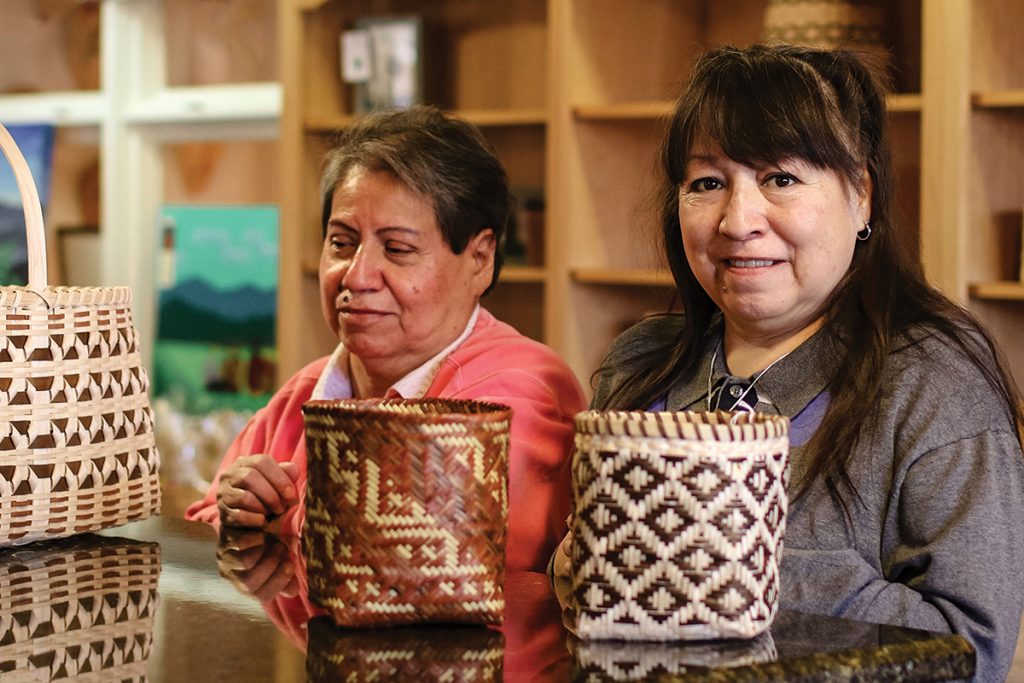
Sisters Lucille Lossiah, left, and Ramona Lossie exhibit at Center for Craft in Asheville this month. Some of their single- and double-weave baskets have traveled around the world.
Portrait by Clay Nations Photography
It wasn’t easy for Ramona Lossie to decide which of the hundreds of baskets she’s woven in her lifetime to include in the Center for Craft exhibit Weaving Across Time: Contemporary Cherokee Basket Making, Land and Identity.
“I wanted to show them all,” she says.
Lossie and her sister, Lucille Lossiah, are two of the nine Eastern Band of Cherokee artists whose self-selected baskets and mats are on view in the show, where artwork titles and artists’ names are displayed in the Cherokee language.
Of the several featured baskets woven by Lossie, the one she likes most is “Noonday Sun Gathering of Clans,” made of rivercane, the traditional design defined in black with butternut dye and orange from bloodroot.
“This basket grew legs and traveled,” she says. “It goes to different shows by itself, to museums outside of the United States. It’s been to Tunisia and just came back from London.”
“Noonday Sun” and Lossiah’s “Sewing Basket with Curls” — white oak and butternut dye — are the first two baskets visitors see of the nearly 50 on display. Both are singleweave, though the sisters have received considerable acclaim for learning and re-introducing the doubleweave technique, a skill that was in danger of being lost as elders passed away.
“It was not being done much anymore,” Lossie says. “It’s one of the hardest weaves, and very difficult to do. The people who take it up need to be respected — they are taking time to stay connected to our people and keep that alive.”
Lossie and Lossiah — who is nearly a decade older than Lossie — learned to weave from their mother, Mary Jane Lossiah, and grandmother Betty Lossiah. Lossie says she made her first basket of white oak when she was about five. “I wanted to do what my mom was doing,” she recalls. “She took me with her to gather materials, dig the roots, and she would tell me stories. If I wasn’t in school, I was with my mom, making baskets. I loved it.”
Harvesting the trees and rivercane, digging roots for the dyes, and cutting the splints is typically done in family groups; the materials are woven into depictions of the landscape and culture and incorporated into a basket or mat. It’s a practice dating back thousands of years, passed from one generation to the next. As Lossie’s mother taught her, she did the same for her daughters — now 31 and 33. With her sister, she began teaching classes at the Qualla Arts & Crafts Mutual and the Museum of the Cherokee Indian.
In addition to the doubleweave, working with rivercane is the hardest skill for younger generations to master, and many never do. “You get blisters working with white oak and maple,” Lossie explains. “With rivercane, you get cut. The ends are sharp, the corners are sharp — it’s like handling glass. It’s a living thing and will bite you.”
She says many of their students decided that rivercane’s bite — and the stitches that often resulted — was not for them. But those who got past being afraid of the material have gone on to cherish the connection to the old ways. One of those is 25-year-old Gabriel Crow, who calls Lossiah and Lossie mentors, and who has several baskets and mats in the exhibit. “When I started working with rivercane I was terrible,” he admits. “I couldn’t cut a piece to save my life. But I kept working on it until I could, and then I got a grant to teach it.” Among his students is another young artist in the show, 27-year-old Dylan Morgan.
Working with the harvested rivercane is one of the challenges; the other is the increased scarcity of the material, now 98% less abundant than it was before European settlers came to the region. As a result, several conservation and environmental organizations are working on rivercane revitalization projects, and those who harvest it practice their own conservation by taking only as much as they need and using — or sharing — all that they take.
Though the designs woven into the baskets — “Chief’s Daughter,” “Flowing Water,” “Snake on a Limb,” “Eye of the Sacred Bird” — are universal, each basket maker weaves distinctively. Lossie says she can identify the makers simply by looking at the basket.
When she went to the Smithsonian in Washington D.C. about 15 years ago to see her basket included in their collection, another immediately caught her eye — and her heart.
“It was labeled ‘Unknown Artist,’ but as soon as I saw it, I knew it was my mother’s basket,” she says proudly. “I spoke with them, and it has been relabeled with her name, Mary Jane Lossiah.”
Weaving Across Time: Contemporary Cherokee Basket Making, Land and Identity shows at the Bresler Family Gallery at Center for Craft through Friday, April 22 (67 Broadway, Asheville, 828-785-1357, centerforcraft.org).